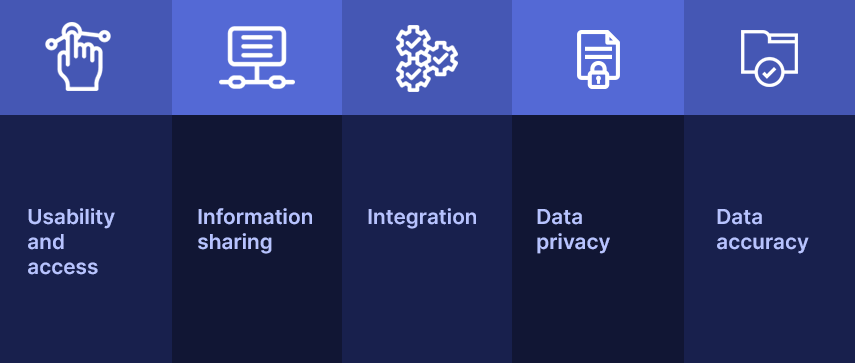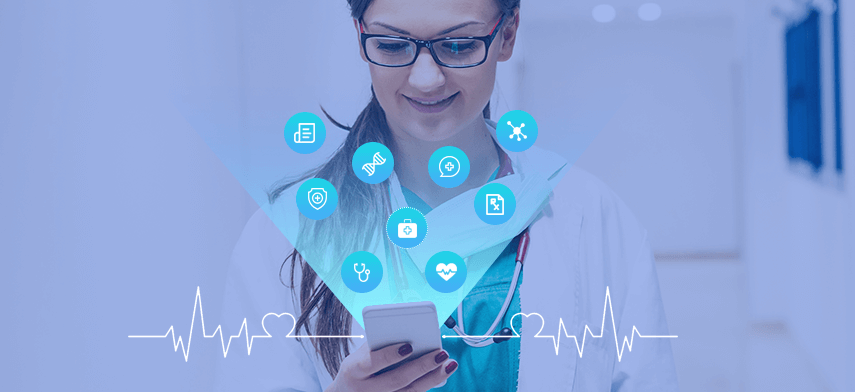Remote monitoring technology has the capability to collect patient data in real-time and in any remote location (outside the hospital). It is evolving amid the current pandemic across the world, allowing patients with chronic disorders or under-recovery from a life-threatening medical condition/ trauma to get back to normalcy without complications. Today, we will determine the critical parameters of remote monitoring technology, the trends in this market, tools and software packages, guidelines to implement the technology, and more.
The remote health monitoring technology helps a healthcare provider access real-time patient data even when it is not under the provider's geographical control. This technology uses different remote monitoring tools and software to gather patient data and deliver it to the healthcare provider. We have discussed in detail about the technology in our previous blog. Per our conversation, today, we will deep dive into this topic and explore more.
Remote Monitoring Technology Advancing Healthcare Operations and Patient Experience
Rapid diagnosis & treatment
The need for remote patient monitoring technologies is higher than before. The demand for specialists is increasing, and it takes days or even weeks to receive medical appointments in case of super-specialized doctors. In such a scenario, the remote monitoring system helps patients get faster and more effective detection or maintenance of medical problems. Since the rapid diagnosis is possible, it is easier for the patients to get back to their routine instead of being caged inside a hospital room.Reduced operational costs
In fact, the rising need for hospital beds can get nullified if a patient can get the same level of monitoring in the comforts of their homes. Apart from this, a hospital can reduce the requirements of several resources, including infrastructure and human resources. Thus, the overall cost of treating a specific medical condition decreases.Easy access to patients’ data
A patient’s data becomes accessible to every doctor within a matter of seconds. Thus, it is easier to get a person’s medical history for further investigation or on-going medical assistance.Higher engagement
Remote monitoring technology helps to increase the patient's experience and fills the demands in patient engagement. Since the patient data is readable by non-medical professionals (by patients and family members), they become more receptive to treatment suggestions and new medicines.Reduction in the probability of re-hospitalization
According to a study conducted by the University of Pittsburgh Medical Center, there is a 76% decrease in re-hospitalization in patients who are using remote monitoring tools. The satisfaction of the patients is also above 90%. Thus, the technology helps to reduce the rate of re-hospitalization.Reduced treatment cost
Such a tool helps hospitals to manage their resources effectively. Thus, the overall cost of treatment decreases. Based on a report by KLAS, more than 17% of healthcare providers cited a reduction in the overall treatment cost.

Remote Monitoring Technology Trends in 2020
2020 is under the more significant problem of COVID-19 pandemic. The remote patient monitoring technologies are now one of the top patient care technologies in many major countries. Many top hospitals like Mayo Clinic, Providence St. Joseph Health, St. Luke's University Health Network, Mount Sinai Health System, and others in America use remote monitoring to observe patients and for Coronavirus infection monitoring.
According to an NCBI study, patients with metabolic conditions and respiratory diseases are the primary beneficiaries of remote monitoring tools. Patients under weight management generally use computerized self-monitoring tools, and cardiovascular patients use biosensor devices.
- The market for remote monitoring technology will be $1.78 billion by the end of 2020. This calculation uses the annual growth of the market as 10.6%.
- While most market share is under the control of the North America region, the fastest growth in this market is currently in the Asia Pacific region.
- In the future, the industry will focus on developing remote patient monitoring technologies for the aging population. This growth is also demanding growth in home-based intelligent monitoring devices.
- Major electronic brands are competing in this market. Apple introduced Apple Watch, which helps to detect AFib, tachycardia, irregular heartbeats, bradycardia, and others.
- Experts predict 8.76% growth in this market from 2020 to 2027.
Consequently, there will be faster growth in this market due to the improvement in the growing healthcare infrastructure and geriatric population. The need to have an independent life is increasing, demanding development in remote video monitoring systems and wearables. According to a study, the remote-based video monitoring system market will grow to 2.7 billion dollars by 2022. So, if you want to implement this continuously growing technology into your system, then you should consider a few guidelines. Let’s discuss this.
Policy and Guidelines For Implementing Remote Patient Monitoring Technologies

1 Usability and access
The efficiency of the remote monitoring system depends solely on usability and access. The data delivered by the system needs to be usable for the specified goal. The patients using these systems will vary in age, literacy level, and others. Thus, a device with ease of updating or using is essential. For better usability and access, the healthcare provider should provide training and support to the patients and customize the devices to suit the specific needs of the patient.
2 Information sharing
The patients using these devices must receive manuals, videos, and other information about using the device. The healthcare providers should receive intensive training about using, demonstrating, and calibrating the device and the software tool.
3 Integration
The device must be compatible with other health information technologies found in different hospitals. Such data integration requires Federal and State law compliance. HIPAA provides laws regarding PHI (protected health information) sharing between the sender, healthcare provider, and the sender's care team (family members, nurses, and others). The data sharing should be flexible to permit sharing across different labs, clinics, pharmacies, and others. Thus, interoperability is an essential element. The device must have the ability to request any data from the repository and establish interoperability with any EHR or technologies found in different healthcare infrastructures.
4 Data privacy
PHI is very sensitive and personal. Thus, data privacy is essential. The device must have the capability to allow remote access. Remote access allows numerous nodal points where data security can get compromised. Thus, the HIPAA recommends the device to provide better security to data storage and sharing. The organization also puts the burden of data security on healthcare organizations. Therefore, any loss or misuse of PHI will be the fault of the healthcare provider. The use of data shared via the device should meet the medical information privacy laws and security laws.
5 Data accuracy
Healthcare data is a matter of life and death. Even a small miscommunication can change the entire course of treatment, leading to undesirable effects. Wrong data entry and very slow data transfer can lead to mistreatment. A remote monitoring technology or device must undergo several clinical trials. The use of technologies should be on the basis of practice guidelines.
Other Guidelines For Implementing Remote Monitoring
Remote monitoring is suitable for patients with chronic disorders, COPD, heart disease, diabetes, and others who need regular visits to the clinic. If your hospital experiences a high rate of re-admission, it is high time to implement remote monitoring tools.
You need to create a centralized data store, preferably cloud, to store your patients' data. This storage should have easy access and reliable data security. Apart from this, you need a local data center to collect data in real-time speed from the sensor. The sensor is the wearable or the device, which varies in various factors based on the medical requirement. On the software side, you need Remote monitoring and management (RMM) tool along with data analysis features. We will see about RMM shortly. Here are the FDA guidelines for implementing remote monitoring in your clinic.
- The device should have a clear description of the function, claim, indication, performance, treatment recommendation, and potential risks.
- The healthcare provider should give clear notice that the device will not cure or treat any condition and is for monitoring purposes only.
- The healthcare provider should share information regarding how to use methods to spot check and others to the patients and the caregivers.
- The devices marked as 'for hospital use' can accommodate in-home use after adequate instructions.
- FDA allows the use of mobile networks, wi-fi, Bluetooth, and other RF methods to communicate between the device and the receiver. However, the channel of communication must be fast and secure.
- FDA quality metrics and standards must get strictly followed
- FDA recommends rigorous testing for data accuracy before usage.
Remote Monitoring and Management (RMM) Tools – Software
Remote monitoring & management software is a collection of services and interfaces that help healthcare providers with IT-specific needs to implement remote health monitoring technology. RMM offers software installation, updates, patches management, configuration, troubleshooting, and other required support. Before we see the top RMM tools in the market, below is the list of factors you should consider while choosing a software.
Easy deployment
RMM software must enable a seamless user interface for both the healthcare provider and the patient. Thus, it should be easy to deploy. Choose tools with push-installation features. Tools with screen sharing facilities will make it easy for better support services. In case of a lack of push-installation, it becomes necessary to install third-party tools like PSA tools, Scripts, Windows Active Directory GPO, and others.
Remote desktop application
Remote desktop control helps in better management. This feature helps to connect with a remote server to deploy any action. It helps to reduce the complexity of troubleshooting. This feature is essential if the patient and the healthcare provider are in different cities. Today, most of the RMM tools are cloud-integrated. Thus, the client apps will help the support team to install the required software.
Dashboard functionality
The dashboard functionality of the tool must determine the usability of the remote monitoring device. The dashboard is where the healthcare provider and the patients would be spending most of the time. Thus, the dashboard should be resourceful, customizable, and easy to manage. The dashboard should give a gist of all actions possible by the device. There should be a separate server for the management and monitoring tools. The dashboard should also show notification about required actions, errors, and, if possible, troubleshooting methods. It should also have an easy sharing button via email or other channels.
Integration features
Data from the device must be integrable with the infrastructure of the healthcare provider. You can choose an RMM with integration features suitable for the infrastructure of the healthcare organization. However, you should choose RMM, which has better integration with different types of infrastructure. Such a feature reduces the complexity of troubleshooting. The latest RMM tools have better integration features than older ones.
Reporting
When it comes to remote monitoring technology, periodic reporting, analysis, and customization of the reports are essential. The reports thus generated must be readable by the patients too. On the receiver side, the healthcare provider should be able to generate complex reports with just a click of a button. No two patients are the same, and thus, the reports required for two patients with the same device might be different. Therefore, the customization feature of the reporting tool is essential.
Pricing
There are two factors to pricing - the cost of the tool and the changes in infrastructure. The tools you use should not increase the overall operational cost or complexity of the process.
HIPAA compliance
HIPAA compliance is essential. It guarantees security, vulnerability analysis, encryption, and others. HIPAA also includes various rules regarding the security and privacy of the data that you share via the tool. Thus, an RMM with HIPAA compliance can give you data security and safety.
Road Ahead...
This pandemic is curbing individuals into the safety of their homes. Thus, remote monitoring technology helps patients get their continuous health facilities without venturing into a hospital or contacting healthcare providers. This remote monitoring helps to improve the depth of telemedicine.
In the future, complex remote video monitoring systems and tools will become more portable, affordable, and reliable. The next new trend in this market is miniaturizing. The devices will become smaller and smaller, allowing patients to experience normalcy with ease. Thus, soon, remote monitoring will become vital and standard care. In the future, remote monitoring will venture into prevention techniques also.
More and more healthcare providers intend to use remote health monitoring devices. This technology will revolutionize the health industry. Clinical-grade monitoring devices are getting developed in advanced technologies. It is essential to choose FDA-approved, HIPAA compliant devices, and build a reliable infrastructure before you start with telemedicine services. The trend of the market is favoring mobile-based portable devices with fast data transfer. The data accuracy and security are the main sensitive elements in this matter. So, if you want to incorporate remote monitoring technology into your system, then contact our healthcare team and improve your patient care.





 August 24, 2020
August 24, 2020


